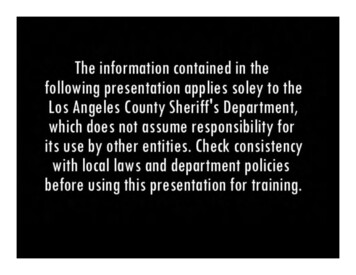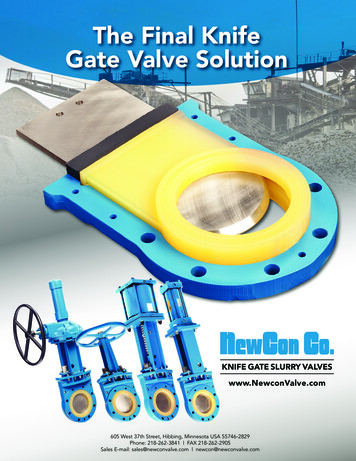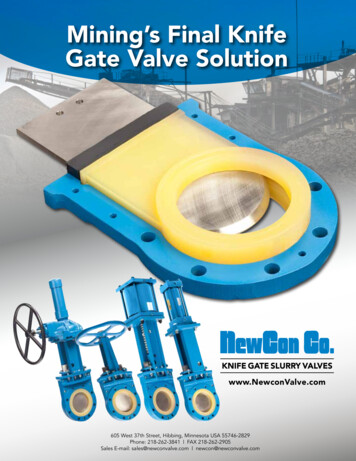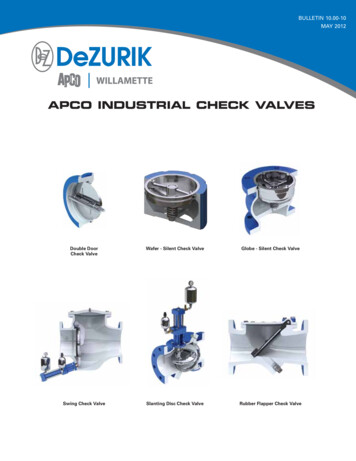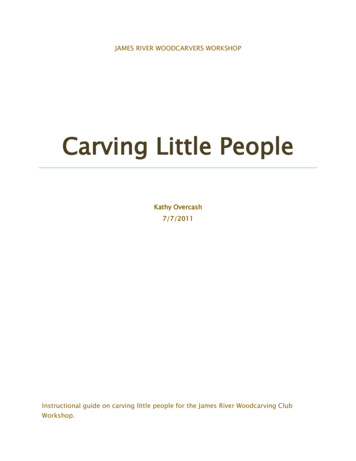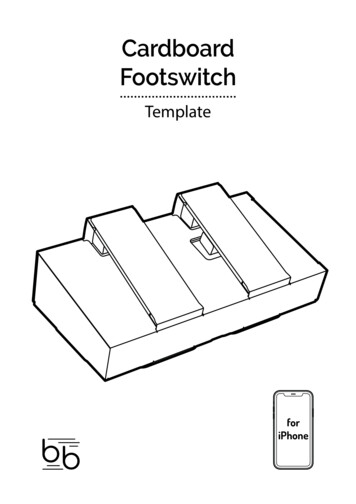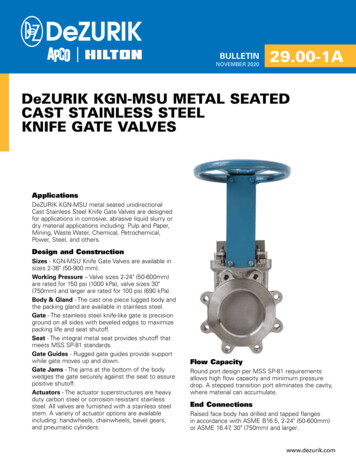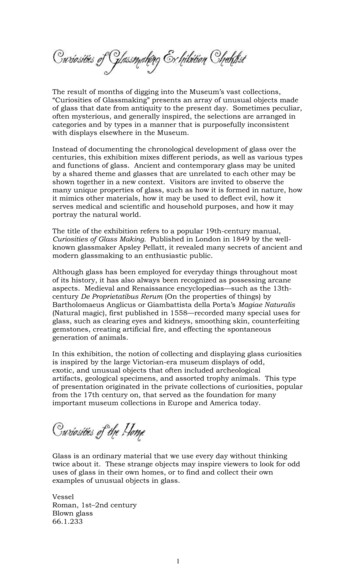
Transcription
Youth Explore Trades SkillsCookIntroductory Knife SkillsDescriptionThe knife is an important basic tool used in the kitchen. In this activity students will learn theparts of a knife; about types of knives, and the materials used to construct them, as well as theimportance of using correct, consistent cutting techniques.Lesson ObjectivesStudents will be able to: handle a knife safely handle a knife correctly correctly place the guiding hand when cutting identify a variety of commonly used kitchen knives correctly identify a variety of knife cuts by their shape and size demonstrate a variety of knife skills, and compare the difference between honing and sharpening knives.Assumptions Students have received orientation on the subject of kitchen and food safety. The teacher will be familiar with and will utilize correct knife skill techniques usingappropriate resources. The teacher will provide a variety of ingredients for knife cutting activity. The facility will supply the correct knives and equipment required to complete the activity.The following Activity Plan is to be completed prior to this Activity Plan: Workstation Set-upSafety Considerations Ensure the use of required personal protective equipment. Practise safe knife handling and use. Use correct knife cleaning procedures. Ensure the proper sanitizing and storage of knives upon completion of the activity.This work is licensed under a Creative Commons Attribution-NonCommercial-ShareAlike 4.0 International License unless otherwise indicated.
Introductory Knife SkillsCookTerminologyKnife Materialscarbon steel: Carbon steel is steel that contains a certain percentage of carbon, whichdetermines the characteristics of the steel.high-carbon stainless steel: High-carbon stainless steel is carbon steel that also containschromium, giving it the best qualities of both carbon steel and stainless steel.stainless-steel alloy: Often used in making cutlery, stainless steel is an alloy of iron thatcontains 10.5% or more of chromium. The alloy is able to resist tarnishing and rust.Types of KnivesFrench or Chef’s KnifeRigid 20-to 35-cm long blade is wide at the heel and tapersto a point at the tip.Boning KnifeA smaller knife with a thin blade used to separate meat fromthe bone. Blade is usually 12.5- to 17.5- cm long and may beflexible or rigid.Paring KnifeA short knife that is used for detail work or cutting fruits andvegetables. Rigid blade is 5- to 10-cm long.Meat CleaverLarge, heavy rectangular blade used for chopping or cuttingthrough bones.Utility KnifeRigid 15- to 20-cm long blade is shaped like a chef’s knifebut narrower.SlicerA knife with a long, thin blade used primarily for slicingcooked meat. A similar knife with a serrated edge is used forslicing bread or pastry items.Butcher KnifeThe rigid blade curve up in a 25- degree angle at the tip, thisknife is used for fabricating raw meat and traipsing throughthe jungle.SteelSteel is uses to hone or straighten a blade immediately afterand between sharpening.Vegetable CleaverUsed as a chef knife in Asian cuisine. Lighter weight than ameat cleaver with a thin sharp blade.Figure 1—Types of knives2Youth Explore Trades Skills
CookIntroductory Knife SkillsKnife PartsTipSpineRivetsCutting EdgeTangHeelThe TangBolster- a portion of the blade that fits inside the handle- the best knives are made with a full tang running the length of the handle- they also have a bolster where the blade meets the handle- cheaper knives may have a ¾ length tang or a thin “rattail” tang- a full tang is best because it provides support, durability and balanceFigure 2—Kinife partsYouth Explore Trades Skills3
Introductory Knife SkillsCookKnife CutsLarge, medium, small ChopCubeDiceJulienneMinceFigure 3—Knife cuts4Youth Explore Trades Skills
CookIntroductory Knife SkillsKnife Cuts & DimensionsJulienneBrunoise1 mm x 1 mm x 4 cm2 mm x 2 mm x 2 mmMatchstickSmall Dice2 mm x 2 mm x 4 cm5 mm squareBatonMedium Dice5 mm x 5 mm x 5 cm7 mm squarePommes FritesLarge Dice1 cm x 1 cm x 7 cm1 cm squarePommes Pont NeufPaysanne1.5 cm x 1.5 cm x 8 cm1 cm x 1 cm x 2 mmTurnedFigure 4—Knife cut dimensionsEstimated Time2 70-minute classesRecommended Number of StudentsUp to 24FacilitiesHome Economics teaching lab and/or Culinary Arts teaching kitchenYouth Explore Trades Skills5
Introductory Knife SkillsCookTools chef’s knives paring knives vegetable peeler cutting boardsMaterialsAn assortment of foods required for knife skills practice (potatoes, carrots, onion, celery, etc.)ResourcesDraz, John, and Christopher Koetke. The Culinary Professional. 3rd ed. Goodheart-Willcox,2017. Pages 173–180 and 188–197.Gisslen, Wayne. Professional Cooking for Canadian Chefs. 8th ed. John Wiley & Sons, Inc.,Hoboken, New Jersey. 20146Youth Explore Trades Skills
CookIntroductory Knife SkillsDemonstrating Skills And KnowledgeProcedureDay 1: Teacher-led ActivityKnife cut station set-up and knife cutting demonstration1. The teacher will demonstrate the proper procedure for setting up a knife cutting station.2. The equipment at the station will consist of a cutting board, chef ‘s knife, paring knife,vegetable peeler, a container of clean water to store knife cuts, clean towel, sanitation,and compost. Class discussion about the importance of sanitation in the kitchen isrecommended.3. The food at the station will consist of three potatoes, two medium carrots, and one onion.4. The teacher will demonstrate the proper cleaning and peeling of each of the vegetables.5. The teacher will introduce the class to each of the knives and their specific uses.6. The teacher will demonstrate large, small, and medium dice using each of the threepotatoes.7. The teacher will demonstrate the batonnet (French fry cut) using the carrot.8. The teacher will demonstrate rough chop and mince with the onion.9. Class discussion to involve the importance of consistency in knife cuts as well as knifesafety, correct technique, and specific sizes of each cut.10. Encourage the class to compare and contrast the knife cuts and to discuss the possibleuses for each of the cut vegetables.11. The class will store and label each of the vegetables properly for future use.12. The class will break down the station and clean the demonstration table.Day 2: Student-led Activity1. The student will set up a proper knife cutting station.2. The equipment at the station will consist of a cutting board, chef’s knife, paring knife,vegetable peeler, container of clean water to store knife cuts, clean towel, sanitation,and compost. Class discussion about the importance of sanitation in the kitchen isrecommended.3. The food at the station will consist of three potatoes, two medium carrots, and one onion.4. The student will clean and peel all of their vegetables, making sure to store peeled potatoesin the container of water.5. The students will use each of their three potatoes to cut small, medium, and large dice.6. The students will cut batonnet with each of their carrots.Youth Explore Trades Skills7
Introductory Knife SkillsCook7. The students will use one half of their onion to produce rough chop and the other half toproduce mince.8. As students finish their knife cuts, have them display each of them on their cutting boards.Remind students of the importance of keeping their station clutter-free and sanitized.Compost to be separated from usable waste.9. Have the class compare their own knife cuts—is the large dice all the same size?10. Have the class compare their knife cuts with the knife cuts of other students.11. Have the class combine the knife cuts for storage. All large dice in one container, allmedium dice in one container, and so on.12. The class will store and label each of the vegetables properly for future use.13. The class will break down the station and clean their stations.Evaluation GuidelinesThe students and teacher can evaluate the knife cuts through measurement and comparison inorder to establish consistent practice moving forward.Students can be evaluated on consistency of cuts, minimization of waste, and following of propersafety and sanitation procedures.Emphasis should be placed on student participation and effort. The students can expect to seeimprovement in their basic knife skills as they progress through each of the cook Activity Plans.Extension ActivitiesStudents should be encouraged to practise their knife skills in an everyday setting in order tosee improvement in their knife skills. Additional knife cuts can be discovered as the studentsprogress through the cook Activity Plan.Creating recipes or dishes that utilize the knife cuts will help the students to understand theirimportance.8Youth Explore Trades Skills
Introductory Knife Skills Cook 2 Youth Explore Trades Skills Terminology Knife Materials carbon steel: Carbon steel is steel that contains a certain percentage of carbon, which determines the characteristics of the steel. high-carbon stainless steel: High-carbon stainless steel is carbon steel that also contains chromium, giving i

